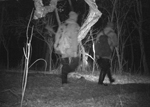|
The 2013 Zoos and Aquariums: Committing to Conservation (ZACC) conference runs from July 8th – July 12th in Des Moines, Iowa, hosted by the Blank Park Zoo. Ahead of the event, Mongabay.com is running a series of Q&As with presenters. For more interviews, please see our ZACC feed. |
-WCS-Russia.600.jpg)
An Amur tiger in the Sikhote-Alin Mountains, Primorye, Russia. Photograph (c) Wildlife Conservation Society Russia Program.
The Russian Far East is one of the wildest places on Earth: where giant tigers roam snow-covered forests and the world’s biggest owls stalk frozen rivers. Bordering northern China and North Korea, the forests of Primorye are known for the diversity of habitats, including coastal forests along the Sea of Japan, vast coniferous forests in the Sikhote-Alin mountains, and even steppe. These diverse ecosystems also makes the forests a hotspot for endangered species, including Amur tigers (Panthera tigris altaica), Blakiston’s fish owls (Bubo blakistoni), and one of the world’s rarest big cats, Amur leopards (Panthera pardus orientalis), which number only 30-50 animals.
Though remote and still wild, threats are rising in these forests: poachers are killing a record number of tigers, logging roads are allowing access to remote areas, prey numbers are constantly threatened by over-hunting, and unsustainable logging practices and bushfires imperil whole forests. Still, the wildlife of Primorye has champions.
Jonathan Slaght first came to the region in 1995 and then returned with the Peace Corps for three years. He was quickly captivated—not by the big cats, but by the birds: most particularly Blakiston’s fish owl, the world’s owl heavy-weight. After years roaming the forests as a birder, Slaght went on to get a PhD in Wildlife Conservation and now works for the Wildlife Conservation Society’s (WCS) Russia Program. While tackling projects for both the Siberian tiger and the Amur leopard, Slaght remains one of the foremost experts on Blakiston’s fish owl.
Slaght recently spoke with mongabay.com about his work in the far-flung forests of Russia, including a rise in tiger poaching, possible good news for Amur leopards, and the recently-discovered hunting habits of Blakiston’s fish owl.
Jonathan Slaght will be presenting on his work in the Russian Far East at the 2013 Zoos and Aquariums: Committing to Conservation (ZACC) conference on Friday, July 12th in Des Moines, Iowa.
AN INTERVIEW WITH JONATHAN SLAGHT

Jonathan Slaght with a Blakiston’s fish owl. Photograph courtesy Sergei Avdeyuk, Amur-Ussuri Center for Avian Bioiversity.
Mongabay: What’s your background?
Jonathan Slaght: My professional interest in Russia preceded my professional interest in conservation. I majored in Russian Language in college (1998, Drew University), then spent three years in the Peace Corps in the Russian Far East, where I realized that all the fun I was having hiking and bird watching could actually develop into a meaningful career in conservation. I went to graduate school, and now have a MS degree in Conservation Biology (2005), and a PhD in Wildlife Conservation (2011), both from the University of Minnesota. I have been working for the Russia Program of the Wildlife Conservation Society (WCS) since 2011.
Mongabay: What drew you to Amur leopards and tigers in East Russia initially?
Jonathan Slaght: To be honest I was not drawn by the leopards or the tigers; birds are my passion. But conservation in Primorye (in the southern Russian Far East) is driven by these big cats, and over the years I have absorbed their conservation issues as my own.
Mongabay: What are the major threats facing these species?
Jonathan Slaght: Without a doubt, the biggest single threat currently facing Amur tigers is poaching, which is true for all tiger subspecies. Amur tigers are the only subspecies to demonstrate a population recovery in the 20th century (with a low of 20-30 animals in the 1940s to an estimated 430-500 in 2005), but those gains are currently being reversed. For instance, in a 12-month period beginning in February 2012, there were a disconcerting number of confiscated tiger parts (belonging to 17-20 tigers) in Primorye, as well as a record number of tiger cubs (nine; representing at least four litters) that had to be rescued from the wild (their mothers most likely having been poached). Summing these losses, and including mothers of orphaned cubs who were likely poached, no less than 30 to 33 tigers were removed from the wild during this 12-month period. While some of these cubs may make it back to the wild if rehabilitation is successful, such a large number of confirmed poaching episodes has never before been reported in Russia. Since detecting poaching cases is extremely difficult, this number could represent just a small percentage of the actual number of poached animals. Clearly, we have a problem.
-J.-Slaght.600.jpg)
Blakiston’s fish owl. Photograph (c) J. Slaght, Wildlife Conservation Society.
Leopards are threatened with poaching as well, but their conservation threats are more diverse given that the last pocket of wild Amur leopards (about 30-50 individuals) is limited to a very small area between the Chinese border, the North Korean border, the Sea of Japan, and the greatest human population density in the eastern half of Russia. As a result of this limited distribution, the relative threat of any one factor is greatly magnified. One of the biggest threats to leopard conservation is seasonal, human-caused fire, which is systematically converting contiguous forest habitat to oak savannah. Amur leopards are also threatened by prey depletion, and because it is such a small population the threats of inbreeding and infectious disease are always looming.
Mongabay: What role do roads play in threatening Amur tigers and leopards? How is WCS responding?
Jonathan Slaght: A number of wildlife species (such as tigers, leopards, and their prey) use logging roads as travel corridors because it is much easier to walk along a flat open surface than through the dense forest, especially in winter, when snow-packed roads or trails provide respite from the deep snows. However, as has been shown the world over, logging roads provide access to poachers, increase the risk of fire, and result in habitat degradation. The roads in Primorye are likely no different. We know that poachers in the Russian Far East use spotlights on logging roads, shining a bright light into the forest and shooting at anything with reflecting eyes. This effective and illegal use of logging roads decimates prey numbers as well as tigers and leopards. Kerley and others (2002) demonstrated the negative impacts of roads on female tigers and their cubs: in roadless areas, tigress/cub mortality was 0% and 10% respectively during the study period, whereas in areas with roads this number was 70% and 55%. As the network of logging roads has expanded over the past 20 years, there are now few places inaccessible to hunters with vehicles, allowing unprecedented access to wilderness areas. With a paltry number of provincial wildlife inspectors spread across this vast region, these logging roads cannot be effectively patrolled.
WCS is responding on several fronts. The first thing we are doing is working with inspectors at four key tiger reserves in the Russian Far East to improve the efficiency of their anti-poaching efforts. By increasing the chances of poachers being caught, our data show that fewer people are taking the risk. Second, we are working with the Amgu logging company to develop a policy framework and confirm the biological necessity of closing down logging roads in tiger habitat. To confirm the biological necessity in the Russian context, we are measuring changes in deer numbers and human use of logging roads before and after closure to demonstrate the impact of illegal hunting, while at the same time, exploring existing forestry codes and regulations to determine the most effective approach to conducting road closures on a larger scale.
Mongabay: A recent survey showed Amur leopard populations on the rise. Is this a cause for celebration?
-WCS-Russia.600.jpg)
An Amur leopard walks a ridge in southwest Primorye, Russia. Photograph (c) Wildlife Conservation Society Russia Program.
Jonathan Slaght: An important caution in the recent press release announcing an Amur leopard population increase was a warning against too much celebration, because their estimate of 48-50 leopards is still a critically-small number. Until the full report is provided (it is expected by July), it is difficult to assess the accuracy of such a press release, or determine the basis for suggesting that numbers have increased 1.5 times. However, WCS has conducted long-term monitoring of leopards in southwest Primorye using camera traps, and data from our intensive survey of this one section of leopard habitat does indeed suggest that leopard numbers have increased substantially, at least in our study area. So we are hopeful that we are seeing a rebound in leopard numbers. The recent creation of Land of the Leopard National Park provides great hope that things will get better, but given the many pressures bearing down on leopards, there is still much to be done to secure a future for this subspecies in the wild. In addition to protecting habitat, prey, and leopards themselves in southwest Primorye, we are working with Chinese counterparts to improve conditions on the Chinese side of the border in hopes of expanding this population internationally, and at the same time are pressing Russian officials to approve a reintroduction program to create a second population of leopards that will provide insurance should something go drastically wrong with the remaining single population. All these steps are critical if we are to ensure the future of the Amur leopard in the wild.
Mongabay: You also work with Blakiston’s fish owl. Few people have probably heard of this species, will you tell us about it?
Jonathan Slaght: In a nutshell, the Blakiston’s fish owl is one of the most charismatic and enigmatic birds in the world. Endemic to northeast Asia, Blakiston’s fish owl is split into two subspecies—a highly-endangered island subspecies (about 50 breeding pairs) living in Japan and the Russian Kuril Islands, and a mainland subspecies (about 2000 breeding pairs) that is broadly distributed along Russia’s Pacific coast. These are massive birds and the largest owls in the world (weighing up to 4.6 kg). I am absolutely captivated by their biology and ecology. Given that they do not migrate, and that they feed primarily on fish such as salmon, their prey is largely hidden under river ice for months on end. Fish owls survive the long, freezing winters by centering their territories around small openings in the river ice, where a hot (or slightly warmer) spring feeds into the main channel. Fish owls have the longest pre-dispersal period (the time between leaving the nest and setting off to find their own territory) of any owl species I am aware of, and longer than most birds: young fish owls disperse somewhere between 14-24 months of age. For comparison, great horned owls in North America disperse after only four months! I could go on and on…
Mongabay: What has research revealed about this owl?
-J.-Slaght.400.jpg) Blakiston’s fish owls spend more time on the ground than many other owl species. Photograph (c) J. Slaght, Wildlife Conservation Society. |
Jonathan Slaght: My research, conducted in collaboration with Sergei Surmach at the Amur-Ussuri Center for Avian Biodiversity, has recently learned a few surprising things about Blakiston’s fish owls. Probably the most interesting is how closely they are tied to waterways. We attached data-logging “backpacks” on eight owls, and collected nearly 2000 locations from them between 2006-2010. The furthest an owl strayed from a waterway was 700 meters. They stay almost exclusively in river valleys, which represent a tiny proportion of the overall landscape.
Also, in our study area the reproductive rate was very low. We monitored seven fish owl pairs for six years, and there were only five chicks fledged successfully in that time. Part of that is because fish owls in Russia only attempt nesting every other year, but some pairs kept having bad luck (like a tree limb falling on the nest during a storm) as well.
Specific ecological restraints, along with their low reproductive capacity, make them highly susceptible to human threats (logging of riparian habitat and roads are primary culprits).
Mongabay: This part of the world is known as being remote and wild. How do locals respond to conservation efforts here?
Jonathan Slaght: The relationship between humans and wildlife (particularly the large carnivores) is complex. In cities (such as the provincial capital Vladivostok) tigers are viewed positively and conservation is generally supported, but in the smaller villages within tiger habitat, many locals consider tigers to be a nuisance or competitors for game meat, and a dangerous threat to themselves and their neighbors. For example, a sick tiger killed a fisherman near Ternei in 2010, and the public image of tigers there has yet to recover. We are working with local hunting leases to increase deer numbers and reduce poaching, and we are also leading a public education campaign for children of Ternei County (this single county has a disproportionate amount of intact tiger habitat), hoping to impress upon the next generation of hunters the value of conserving Amur tigers in the wild.
Mongabay: What can people do to help wildlife in Russia’s Far East?
Jonathan Slaght: The Minnesota Zoo has spearheaded an effort through the Association of Zoos and Aquariums called the Tiger Conservation Campaign, in which funds from a number of zoos are pooled and sent directly to the best tiger conservation efforts in the world, including several of WCS’s projects in Russia. Supporting the Tiger Conservation Campaign will result in much-needed funds going directly into conservation programs. People can support their local zoos, and ensure that these zoos contribute to the conservation effort.
-J.-Slaght.600.jpg)
In winter, Blakiston’s fish owls catch fish along river stretches that resist freezing. Photograph (c) J. Slaght, Wildlife Conservation Society.
-J.-Slaght.600.jpg)
Blakiston’s fish owl with juvenile Masu salmon. Photograph (c) J. Slaght, Wildlife Conservation Society.
Related articles
Amur leopard population rises to 50 animals, but at risk from tigers, poachers

(04/09/2013) In the remote Russian far east, amid pine forests and long winters, a great cat may be beginning to make a recovery. A new survey estimates that the Amur leopard (Panthera pardus orientalis) population has risen to as many as 50 individuals. While this may not sound like much, it’s a far cry from the a population that may have fallen to just 25 animals. Sporting the heaviest coat of any leopard, the Amur leopard largely hunts hoofed animals, such as deer and boar, in a forest still ruled by the Siberian tiger.
Animal picture of the day: the world’s biggest cat
(02/07/2013) The Amur tiger (Panthera tigris altaica), also known as the Siberian tiger, is the world’s biggest cat. An adult male weighs on average about 390 pounds (176 kilograms). The largest yet recorded weighed 460 pounds (207 kilograms), although there are reports of considerably larger animals in the past.
‘Exporting deforestation’: China is the kingpin of illegal logging
-EIA.150.jpg)
(11/29/2012) Runaway economic growth comes with costs: in the case of China’s economic engine, one of them has been the world’s forests. According to a new report by the Environmental Investigation Agency (EIA), China has become the number one importer of illegal wood products from around the world. Illegal logging—which threatens biodiversity, emits carbon, impoverishes local communities, and is often coupled with other crimes—has come under heavy pressure in recent years from the U.S., the EU, and Australia. Each of these has implemented, or will soon implement, new laws that make importing and selling illegal wood products domestic crimes. However, China’s unwillingness to tackle its vast appetite for illegal timber means the trade continues to decimate forests worldwide.
Conservationists turn camera traps on tiger poachers

(11/12/2012) Remote camera traps, which take photos or video when a sensor is triggered, have been increasingly used to document rare and shy wildlife, but now conservationists are taking the technology one step further: detecting poachers. Already, camera traps set up for wildlife have captured images of park trespassers and poachers worldwide, but for the first time conservationists are setting camera traps with the specific goal of tracking illegal activity.
IKEA logging old-growth forest for low-price furniture in Russia

(05/30/2012) A new campaign is targeting IKEA, the world’s biggest furniture retailer, for logging old-growth forests in the Karelia region of Russia. An alliance of groups, headed by the Swedish NGO Protect the Forest, allege that IKEA’s subsidiary, Swedwood, is clearcutting thousands of hectares of old and biodiverse forests. But, Swedwood’s 300,000 hectare concession is certified by the Forest Stewardship Council (FSC), generally considered the world’s strongest forestry certifier.
Russia creates massive park for rare cats
(04/13/2012) Russia has created a massive national park to protect some of the world’s rarest big cats, the critically endangered Amur tigers and leopards, reports the Wildlife Conservation Society (WCS).
Russia, South Korea sign agreement to resurrect woolly mammoth

(03/19/2012) Last week Russian and South Korean educational facilities signed an agreement to work together to bring back the woolly mammoth (Mammuthus primigenius) from extinction. The project will be headed by Hwang Sooam of South Korea’s Bioengineering Research Institute and will involve implanting a woolly mammoth embryo into a modern elephant.
New meteorological theory argues that the world’s forests are rainmakers

(02/01/2012) New, radical theories in science often take time to be accepted, especially those that directly challenge longstanding ideas, contemporary policy or cultural norms. The fact that the Earth revolves around the sun, and not vice-versa, took centuries to gain widespread scientific and public acceptance. While Darwin’s theory of evolution was quickly grasped by biologists, portions of the public today, especially in places like the U.S., still disbelieve. Currently, the near total consensus by climatologists that human activities are warming the Earth continues to be challenged by outsiders. Whether or not the biotic pump theory will one day fall into this grouping remains to be seen. First published in 2007 by two Russian physicists, Victor Gorshkov and Anastassia Makarieva, the still little-known biotic pump theory postulates that forests are the driving force behind precipitation over land masses.














